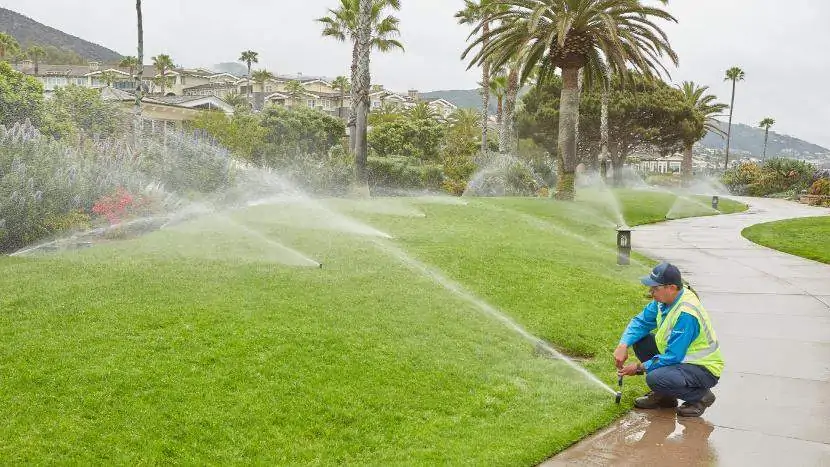Landscape irrigation systems have changed significantly in the last twenty years. More intelligent technology makes them easier to use and customize to save time and money.
In some regions of Minnesota, landscape irrigation systems are used so frequently that water conservation has become a top priority. Irrigation systems must be designed for efficiency and maintained regularly to maximize their performance.
Most homeowners are usually less concerned with design and more with minimizing their initial landscape irrigation system investment. Yet, in addition to operating efficiency, even technology upgrades are easier if that design is sound.
For this reason, we will begin with design to examine what homeowners need to know about their automatic irrigation system.
Landscape Irrigation System Design
There are a number of factors to consider when designing an landscape irrigation system in Minnesota. Due to variable weather and site-specific conditions, the design process is part science and part trial and error.
Maximize Water Pressure
It’s not uncommon for water pressure to fluctuate in some municipalities. To balance the demand on the community supply, water is effectively rationed by limiting the days and times watering is permitted. A more efficient irrigation system is invaluable in these circumstances.
Strong water pressure makes your sprinkler system work better. It also eliminates the need for low-pressure nozzles and costly booster pumps.
Booster pumps can be a significant but necessary investment. By increasing the water pressure in the system, water can flow farther and more uniformly.
One common cause of low water pressure is a reduction in pipe diameter at its source within the home. A licensed plumber can readily fix this for a reasonable amount. The increase in pressure will not be great, but it increases efficiency and run time.
Related article: Understanding Summer Lawn Care In Minnesota : Weeds, Fertilizer, Mowing, & More
Water For Soil Type And Slope
All landscapes are sloped for proper water management, with unique areas using supplemental systems for proper drainage.
If a planting bed or lawn area is steeply sloped, that must be factored into the location of irrigation heads. In some circumstances, drip irrigation may be used in conjunction with spray heads.
Our Minnesota soils are mostly dense and clayey. They will hold a great deal of water but will not absorb it quickly. Watering frequency and duration are key design factors for managing this.
Select Nozzles To Dial In Water Supply
Irrigation nozzles are easily replaced by unscrewing them from the irrigation head. When the nozzle is removed, just below it is a filter that may become clogged with grass clippings or other debris. Each new nozzle comes with a fresh replacement filter.
Nozzles can be selected for full, half, and quarter circle patterns. Adjustable nozzles will fine-tune these patterns from one-quarter to slightly less than a full circle.
Other variations are the height, distance, and nature of the water pattern. For example, low-flow nozzles are used in tight areas where the desired amount of water is minimal.
Homeowners can buy the most common nozzles at garden centers and home improvement stores. It’s a good idea to keep a few on hand in case one is accidentally damaged with a lawn mower or shovel.
Landscape Irrigation Maintenance And Adjustment
Irrigation system designs must be field tested to achieve optimum performance. Industry experts sometimes recommend operating the system through all of its cycles in normal conditions. Then spot check the soil to ensure coverage is complete and the soil sufficiently moist.
It is recommended that these checks be recorded to understand changing seasonal conditions and issues that may reoccur.
- Is coverage 100% with complete overlap?
- Is your water usage consistent with recent conditions?
- Is the controller backup battery fresh?
- Do any of the zones call for timing adjustment?
- Are electronic valves opening and closing completely?
- Are nozzle adjustments necessary due to windy conditions?
- Are nozzle filters free of debris?
- Should nozzles be adjusted or changed to fix excessive runoff?
- Is it best to relocate or remove heads due to maturing plants?
You are looking for anything that requires immediate action, most importantly, any potential leaks. Fortunately, there are now system upgrades you can make to get this data automatically.
Smart Sprinkler Systems and Enhancements
Smart systems are enhancements that introduce new ways to manage water usage, such as in-ground moisture sensors. The question is whether the additional expense and effort are justified.
The investment in smart residential controllers, sometimes known as weather-responsive controllers, is worth considering, especially for water conservation.
In most cases, they can easily adapt to legacy systems. Simply disconnect the old controller and connect the new smart controller to your Wi-Fi system.
Homeowners who travel frequently may benefit greatly from these upgrades. There’s peace of mind knowing everything is working well, and if the system isn’t, it’s comforting to know it can be diagnosed and disabled if necessary.
Green Grounds Landscaping: Helping Minnesota Homeowners Enjoy Outdoor Living
Our top priority is creating living spaces that are right for you. We pride ourselves on working with you from concept to construction and maintenance to create the right landscape in Minnesota for your needs.
Contact us today for a free consultation to explore your next landscaping project.



Recent Comments